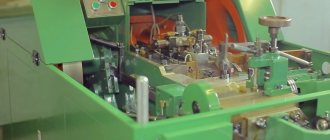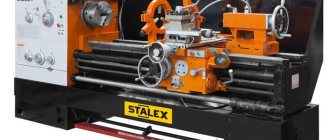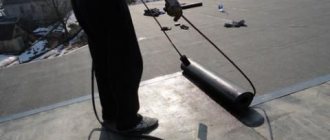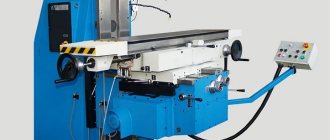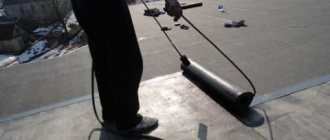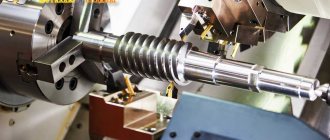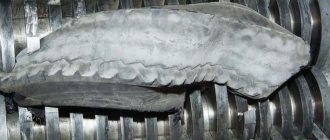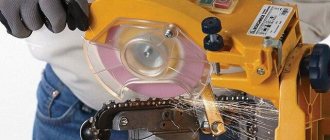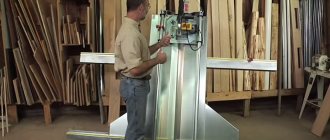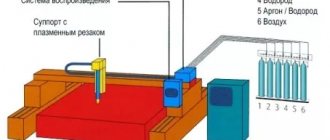Sawing with a format saw
To cut with a machine, the workpiece is placed on the left fixed table up to the adjustable stop.
The required length is measured. The saw unit starts. When the disk reaches the required speed, the table moves forward. The workpiece, together with the table, is fed onto the disk for sawing off the desired piece.
Basic machine settings:
- workpiece position;
- depth of cut;
- cutting angle.
There are three types of machines:
- light (designed for a workload of five hours);
- medium (8-10 hours);
- heavy (16-20 hours).
Design
The most popular models are Mj 45kb-2, JTS-315SP SM, Woodtec ps 45, Altendorf F 45. Despite their different features, they have a common design.
Required components of a cutting machine:
The bed is the basis on which all mechanisms are attached
Heavy beds eliminate vibrations and vibrations, which is extremely important for precise cutting. Saw unit consisting of two discs
The first disk is located in front of the unit and is used for preliminary filing of the workpiece. The second is for completely sawing the slab. Three desktops. The first one is stationary; a node is located on it. The second, format, is movable; it feeds the slab onto the disk. The third supports the parts to be sawed off. The carriage is a part that allows the format table to move. Stops and rulers that secure the workpiece in the required position.
Depending on the model, price and cutting features, machines may have different design nuances.
Additional components of the machine:
- a pipe that removes shavings and sawdust and connects a dust removal system;
- clamps for securely securing the workpiece to the table;
- a rotating ruler and corner stops, with the help of which the cut is made at the desired angle and without markings;
- frame with a stop leg for cutting long workpieces;
- ball and roller carriages.
The first formatting machine with a moving carriage was assembled in 1906 by the German carpenter Wilhelm Altendorf.
How to save: the main problems of modern machines
How to make a format-cutting machine with your own hands
In order to reduce the prices of machines when selling, and thereby attract the attention of the buyer, manufacturers have to use materials of lower strength and inexpensive components when developing and selling format-cutting machines. The plant’s attempts to take its place in the market using such methods are of course natural for me in view of the development of a market economy
However, the negative aspects of such savings when constantly working with the machine appear after some time.
The plant’s attempts to take its place in the market using such methods are of course natural for me in view of the development of a market economy. However, the negative aspects of such savings when constantly working with the machine appear after some time.
Problems arise most often with guides, which can also wear out unevenly. This in turn affects the accuracy of the machine.
Another problematic element may be the saw block. If the manufacturer has not thought through the convenience of working with the saw unit, then the process of setting various parameters - be it replacing drive belts, setting the tilt or positioning of the scoring saw - will lead not only to time, but also material costs, not to mention wasted nerves.
If you have qualified personnel on staff who can deal with more complex elements of equipment, then I would advise you to take a closer look at machines with electronic motor control units. Such improvements have become widespread due to the ability to widely adjust the speeds of the saw unit. Also, the introduction of such technologies helps to save on energy consumption of equipment in general.
In order to save money when purchasing equipment, there is a method for selecting a machine that will be “tailored” for specific tasks. “Special series” is sometimes called a selection of machines of this kind. The principle of selecting such equipment is similar to the Lego principle. For example, there is no need to purchase a machine with a scoring saw unit with a separate drive if you need to cut solid wood. But such a package would be an undeniable advantage when processing laminated chipboard (laminated chipboard).
In my opinion, it is better to purchase an optimized machine for certain tasks and lose a little in so-called “versatility”, but at the same time save money, than to buy the most budget option with a greatly simplified element base.
Classification of machines
By class, machines are divided into:
- household;
- industrial.
Type:
- horizontal;
- vertical;
- CNC batch cutting centers.
The power range of format-cutting machines ranges from 3 to 22 kilowatts. The weight of industrial machines is from 330 kilograms to 10 tons, small-sized household machines from 50 kilograms.
Advantages of this type of equipment:
- Reliability in operation.
- Made from high quality materials.
- Quality of raw material processing.
- Stability of the machine on the surface.
- Large surface to work with.
- Affordable and reliable system for machine control.
- Motor protection against cooling and overheating
The disadvantages include:
- Large dimensions of the machine, which requires adequate space for work.
- High power consumption.
Getting to know the machine
How to make a metal lathe with your own hands
This formatting equipment, manufactured in an industrial environment or independently, performs the task of cutting many materials:
- wood of different species;
- plywood;
- veneer;
- chipboard;
- MDF;
- Fiberboard;
- laminate;
- sheet composites;
- facing plastic;
- melamine.
It is possible to cut these materials without chipping thanks to the installation of a separate small-diameter saw on the formatting machine, which performs preliminary cutting on wood in the line of action of the main disk.
Main parts
Each format cutting unit includes the following structural elements:
- bed;
- main table (fixed);
- additional table (movable);
- cutting unit (saw);
- guides;
- additional equipment.
Saw unit
This part of the cutting machines is a solid block on a frame, consisting of 2 saws with electric motors with power from 3 kW to 5.5 kW. The height of the location above the table is on average 0.08 - 0.13 m, set by manual adjustment or electromechanical drive. The tilt angle varies from 0 to 46° using rotary sectors.
Scoring disc Ø up to 120 mm, speed 8000 rpm, has rotation directions along the workpiece. To reduce changeover time, the Felder panel saw has a system that allows you to move the scoring element to the side at the touch of a button. This is necessary when a large-diameter main disk is needed to produce a part on a felter.
The device of the saw unit
The main saw rotates at a speed of 4000 - 6000 rpm against the direction of sheet feeding. The operating mode is set depending on the hardness of the material (cutting wood, laminated boards, laminated chipboards, packages).
Vertical movement occurs in 2 ways: rotation around a horizontal axis, sliding along vertical guides. When installing the cutting unit in different positions, the saws continue to be in the same plane relative to each other. The rotation axis is designed and made using trunnions so as to prevent the rotating knife from jamming in the stationary part of the format table.
Tables
The fixed base is a smooth milled cast iron plate. Increasing the size of the working area for large-sized furniture material is achieved by additionally attaching planes (extending, widening) and moving the stop ruler.
The cutting sheet is placed on the base plane of the movable table. The structure is assembled rigidly on the carriage, excluding deformations under the maximum permitted weight of the package. The material of manufacture is aluminum. It combines strength (multi-chamber profile) and low dead weight. To avoid traces of friction between the table and the workpiece during the production process, aluminum undergoes special processing (anodizing).
Roller carriage
Components of the moving table:
- carriage;
- support frame;
- corner stop ruler;
- folding stops;
- telescopic stops.
The length of the carriage is on average 3.2 m, which allows you to lay raw materials that correspond to standard sizes for chipboard and most other sheet materials. The extension of the cutting unit beyond the edge of the cut is 20–30 cm.
Table movement mechanism
The movement of the trolley occurs along prismatic guide profiles by means of rollers (balls) held by a separator. Rotation elements can be steel or plastic. The V-shaped guide profile is made of steel. The cross-shaped arrangement of the X-Roll ensures uniform load distribution and smooth running. Vibrations and distortions are eliminated by a system of regulators and compensators.
Additional equipment
The accuracy of formatting and cutting processing on the machine is increased by automation of work, stopping, returning to the starting position, the ability to program operations, and monitoring the process on the equipment control panel. Cutting machine models presented in the furniture industry (Russia) are equipped in various options:
- electric brake of the main saw;
- high power engines;
- disk rotation speed regulators;
- lubrication system;
- electromechanical drives for adjusting the position of components and devices;
- clamping devices for workpieces;
- vibration sensor;
- additional stops, rulers;
- programming, indication, protection blocks;
- systems for localizing chips and dust;
- retractable support frames.
Tools
0 votes
+
Vote for!
—
Vote against!
Many owners are wondering what equipment is required for high-quality production of cabinet furniture. Experts say that these are format-cutting machines, which are popularly called format circular saws or circular saws with a carriage. Each owner can assemble such a device with his own hands.
Purpose of the format-cutting machine
Format cutting equipment is intended for transverse, longitudinal cutting of lumber and cutting at a certain angle, format trimming and cutting of panel blanks, including the removal of overhangs after their cladding, as well as for the purpose of cutting full-size boards into blanks of a given size.
Format-cutting equipment, which is used in the production of cabinet furniture, allows us to produce high-quality finished products. The function of these machines lies in setting the basic parameters of furniture parts for subsequent processing. Such machines are designed for piece and batch cutting of workpieces.
Factory-made and home-made format-cutting machines work with different materials: various types of wood, plywood of any thickness, MDF panels, chipboard, fiberboard, including composite sheet materials lined with plastic, laminated paper and film materials, veneer and melamine. This equipment is usually used for cutting material that has precise geometric dimensions.
Format saws are used in small-scale production, medium- and large-scale furniture factories, as well as in small carpentry workshops. The possibility of preliminary cutting of workpieces with a separate saw directly under the cutting area allows you to cut workpieces lined with natural or artificial material without chipping the lining.
Design of a panel saw
Structurally, format-cutting machines consist of the following elements: a bed, a fixed working table and a movable additional table (carriage, trolley, support frame, separator, ruler), a saw unit consisting of 2 saw blades, guides,
Saw unit
The welded design of the sawing machine guarantees a high level of stability and absence of vibration during sawing. When cutting veneered slabs, the main problem is the formation of chips on the lining in the area where the saw blade tooth comes out. To cope with this problem, the drawings of panel saws provide a saw unit with two saw blades.
The saw unit is a one-piece assembly that is cast from cast iron. Two electric motors are installed on its body, which rotate the scoring and main saw blades using a belt drive. The scoring disc is located closer to the workpiece, its size reaches 120 millimeters, and in the same direction the rotation speed reaches 8000 rpm.
This disk is required for cutting the cladding layer from the side where the teeth of the main disk come out, which rotates in the opposite direction to the workpieces and makes the main cut in the slab, as shown in the video about the sawing machine. This design allows you to get an even and clean cut that is not spoiled by burrs and chips.
On some types of machines, a saw unit is installed using special rotary sectors, which can be adjusted to cut at an angle. In this case, the ratio of the scoring and main saw blades is not violated. The saw unit can be installed on a work table or on a stand.
Founded saw
In format-cutting machines, the rotation speed of the main saw ranges from 4 to 6 thousand revolutions per minute. Continuous speed adjustment allows you to quickly set up the format-cutting machine and accurately select operating modes for different materials being cut. As a rule, the saw drive power is 3-5.5 kilowatts. Remember that high power consumption, which is usually characteristic of a technological process in which sawing a package of sheets or cutting hard wood, is not always appropriate.
The height of the cut or the position of the main saw in format-cutting machines is set by vertical movement of the saw unit. In this case, two methods are used: along vertical guides and by swinging around a horizontal axis. The maximum height to which the saw rises relative to the table must be indicated in the technical specifications of the unit.
Traditionally, it reaches 80 - 130 millimeters. When the saw is tilted, this figure decreases accordingly. Some models provide automatic raising and lowering of the saw, powered by an electric drive, sometimes even setting the height using the control panel.
The saws of a format-cutting machine usually have an inclination of up to 45 degrees, as in the photo of format-cutting machines. This will cause the entire saw unit to tilt. Thanks to the presence of special trunnions, the horizontal axis of rotation of the machine runs along the line of intersection of the plane of the fixed table and the main saw, which eliminates jamming of the saw in the table slot. This function is necessary in the manufacture of cabinet furniture elements.
Movable and fixed table
The main fixed table, which is cast from cast iron, has an upper milled surface, the dimensions of which can be adjusted by additionally installing extension and expansion tables on it and a parallel stop ruler that can move.
The movable table consists structurally of a carriage, which is made of a multi-chamber aluminum profile, a support frame, an angular stop ruler, which has folding stops and a telescopic extension, a support frame and its support. The carriage, thanks to its own design, is resistant to bending and twisting loads.
Most often in furniture production, format-cutting machines with a carriage length of approximately 3200 millimeters are used. This is the most suitable solution for devices with a movable carriage, because it matches most of the dimensions of the plates that are used by enterprises.
You should not chase the high prices of format cutting machines, believing that they work better. Remember that the longest cutting length will always be less than the carriage stroke if you have a scoring saw. To completely pass the sawing zone, the workpiece requires an additional 200-300 millimeters.
To move the workpiece, a roller carriage is used that moves along steel guides, and a separator with balls or rollers that moves between V-shaped steel guides. To adjust the main table or saw that is movable relative to the plane, the design of format cutting machines, as a rule, provides appropriate compensators or regulators.
Guides and carriages
The movable table of format-cutting machines serves as a base surface intended for laying the slabs to be cut; it must withstand the weight of the material. The load is taken by the carriage itself and its guides. If they are not rigid enough, the carriage guides will be subject to not only vertical loads, but also torque.
Due to the significant length of the lever, the application of load at the contact points of the rollers or balls in linear guides reaches a maximum value. Therefore, special guides are used in machines with a carriage, which ensure ease of movement and eliminate the occurrence of gaps in them, which directly affects the processing accuracy of the workpiece being cut.
Different machines from different manufacturers use guides of different designs using rollers, balls and their combinations. The most common design, regardless of the cost of the saw, is an aluminum carriage that moves along steel guides on linear ball bearings.
The guides are often made in the form of steel strips, which are built into the aluminum carriage body in such a way that two “channels” are formed to accommodate the balls. Such a “prismatic” circuit is capable of absorbing loads in any direction. To increase the service life of the lining, the structure is subjected to thermal hardening before installation. And anodizing, which prevents the appearance of stripes on the workpiece due to aluminum contamination.
There are also guides in which the balls are not steel, but plastic, the rigidity of which is achieved by using an aluminum profile with a large number of internal ribs. Some guides have built-in wear compensators, but this unit usually cannot be repaired at home.
Additional options
Many panel saws are equipped with digital position indicators for stops and rulers, which are mounted directly on them. There are also machines in which the current position of the ruler or stop is set on the monitor screen using a control panel, and then such devices are moved to the specified position automatically by an individual electric drive.
On format-cutting equipment, the following can be used as standard or additional equipment:
- electric braking system for the main saw blade,
- adjusting the speed of movement of the main saw blade,
- system of automatic lubrication and angle adjustment of the saw unit,
- electromechanical drives,
- electric motors with increased power,
- upper protection of saw blades, which is equipped with a pipe for removing sawdust,
- pneumatic or eccentric clamps for holding workpieces,
- additional support frame,
- rotating ruler for cutting blanks and slabs at an indirect angle,
- double corner stop,
- vibration sensor,
- system of protection against ingress of chips and dust.
Manufacturing of a panel cutting machine
If you are planning to start making cabinet furniture, then you should ask how to make a format-cutting machine. Its operating principle is simpler than simple, but the price of a factory-made format cutting machine is quite decent. Not every private owner can afford to buy such equipment. But assembling a machine with your own hands is possible for every person who is able to handle tools and is at least a little familiar with technology.
During the work you will need: metal pipes, channels and metal angles, two electric motors, a main dust and scoring disk, shafts from agricultural machinery, fasteners (nuts and bolts), a set of metal tools, a welding machine.
First, you need to make a strong steel frame for the panel saw using metal channels. The dimensions of the blanks for the base should be as follows: length of the machine 6500-6700 millimeters, width 2500 millimeters, height 800-1100 millimeters. Then construct the main and floor guide of the machine and fix them on the bed. For the manufacture of guides, it is customary to use a pipe that has dimensions of 60 by 5 by 6500 millimeters.
The movable work table must be made to move along a guide, because the table will feed the sheet during operation. Provide a cutting line length of 3000-3200 millimeters. If desired, you can increase or decrease this parameter; to do this, you only need to change the length of the guides.
Hang two saws on the machine – a scoring saw and a main saw. The saws should be installed on the saw unit; they rotate towards each other and are driven by two asynchronous motors. Be sure to provide the possibility of tilting the block at an acute angle of up to 45 degrees. For this purpose, equip the saw unit with a special rotating mechanism.
Be careful when choosing motors, because they drive the saws. The motor power must be at least 2.9 kW. The motors must rotate the main saw at a speed of about 5000 rpm, and the scoring saw at 8000 rpm. In the design of the machine, use saw blades with a diameter of 250 millimeters, which allows you to cut laminated chipboards and trim sheets.
To safely use do-it-yourself sizing machines in the production area, provide good exhaust ventilation, because wood particles can ignite from the smallest spark generated when the engines are running. Given the high speed of movement of the saw blades, it is recommended to exercise extreme caution when working on the machine, since disks that rotate at high speed can cause injury to the worker, including loss of the hand and entire limb.
After making a format-cutting machine at home, you can begin to directly process the material. Sheets usually have large dimensions, so before installing the sheet into the mechanism, it is worth making initial markings in the places where the cuts will be made. The size of the workpiece should be larger by at least 7 - 8 millimeters on each side. After creating a small stack of blanks with markings, you can start cutting and trimming the material.
What machine parameters should you pay attention to when selecting
Screw-cutting lathe TV-6
When choosing format-cutting equipment, it is important to take into account the volume of work performed, on which the following characteristics will depend:
- power of the main and scoring saw;
- length and depth of cut;
- design features of the saw unit and movable carriage;
- the presence of additional functions and regulatory mechanisms;
- weight and dimensions of the unit.
https://youtube.com/watch?v=X5eoLLBWZKI
What type of equipment is chosen for the manufacture of products will directly affect the final quality of the products produced. Machine tool manufacturers take into account important technological features of processes in both large and small enterprises. Therefore, each unit is modernized to meet the specific needs of production.
Cutting quality of laminated chipboard
Supporting Information.
Machines for cutting sheet materials
TO
category:
Woodworking machinery
Machines for cutting sheet materials
Next: Mixed cutting machines
Machine design. For trimming furniture panels on four sides and cutting sheet materials, TsTZF-1 and TsTZF-2 machines are used.
Slabs measuring 1850X3750 mm are opened on a program-controlled TsTMF machine, and format processing of panel parts is performed on TsF2 machines.
The three-saw format-edging machine TsTZF-1 consists of a welded frame with two rail guides mounted on frame posts.
A carriage with the material to be cut is installed on the guides. On the side of the machine there is a control panel, a hydraulic station and a hydraulic drive. Two longitudinal supports with saws and a transverse support with a saw for cross-cutting are mounted on the traverse.
Calipers allow you to lower or raise saws using handwheels, depending on the diameter of the saws and the thickness of the bundle of slabs being cut. Longitudinal supports on the traverse are set to a given width of the parts being cut manually using a handle through a chain drive.
The cross-cut caliper is fed along the traverse from a hydraulic motor through a system of pulleys by a cable.
Rice.
Carriage
A device that drives a movable table. The carriage is the key element of the machine. The cutting accuracy depends on its type and quality (approximately 0.1 mm per 1 m of cut). Moreover, once tuned, the carriage should remain accurate for more than one year!
There are two types of carriages of format-cutting machines:
- roller; - ball.
Which is better? The manufacturers themselves will not tell you exactly, since each type has its own advantages.
Roller carriages provide greater accuracy and can withstand heavy loads, so they are suitable for heavy, hard-working machines, but they are also more expensive. Ball carriages are less durable, but cheaper and more suitable for small production.
The material of the carriage is also important; it is usually a durable and lightweight aluminum alloy. There are “budget” roller carriages, where the rollers are not entirely metal, but partly made of plastic. The service life of such a carriage is lower. Although, if used correctly, the carriage will last over the warranty period of 5-6 years.
What parameters to pay attention to when choosing a machine:
- - type and length of the carriage: the accuracy of the cut and the durability of the equipment depend on the first, the length of the cut depends on the second, that is, the maximum size of the part that you can cut - usually 3200 mm;
- — saw diameter: the height of the cut, that is, the maximum thickness of the workpiece, depends on it;
- — engine power, on which productivity depends, and the installed power of the machine, that is, the sum of the powers of the main and scoring saws.
Additional useful options for panel saws:
— the presence of a protective aspiration system - the machine is equipped with a device that, like a vacuum cleaner, catches and sucks out sawdust during operation. This option is very important for your health, since breathing the smallest sawdust is hardly beneficial!
— the presence of pneumatic clamping of the saw is also important for work safety. The workpiece is securely fixed, thanks to which, firstly, your fingers will not get under the saw; secondly, the cutting accuracy will increase
Modern models of furniture machines have many more different options, but the ones listed are quite sufficient for successful work in a small production.
Parameters of sawing machines
When choosing a sawing machine for chipboard, the following parameters should be considered:
- Engine power. Household models are usually equipped with motors with a power of up to 2 kilowatts. Stationary models, especially those aimed at large cutting volumes, large thicknesses and high material densities, have 5-kilowatt motors.
- Cutting depth. Determines the maximum thickness of the workpiece being processed. Varies in the range of 4-14 cm. It is standardized separately for cutting at right angles and at 45°.
- Weight. Household machines are designed so that one person can carry it without straining. Their weight usually does not exceed a couple of tens of kilograms. Stationary machines weigh up to 150 kilograms.
- Supply voltage. Desktop models operate on 220 volts. Powerful floor-standing ones are available for both 220 and three-phase voltage 380 volts.
The structure of the saw unit of a sawing machine
A big name with an impeccable reputation guarantees high quality and long service life, but significantly increases the price.
Features of choice
If the buyer has already decided on the type and configuration of the equipment, then finally he should also pay attention to the following characteristics:
- Engine power. Lightweight machines have a motor with a power of 1.5 - 2 kW. This is sufficient for sawing thin plywood and fibreboards. In the case of wood chips, the cutting speed will be low. For cutting a single layer of large format, machines with a power of up to 4 kilowatts are suitable. Industrial units operating from a three-phase power supply allow cutting material in batches and stacks, and their power reaches 6 - 8 kW.
- Disk size. The frames and attachment points for the equipment are made in such a way that it is possible to fasten the disk in a certain range of sizes. A 200 mm disc is considered the minimum standard, and 550 mm can be installed in heavy and some medium-sized devices. The maximum thickness of the material being cut depends on this parameter.
- Speed. The cutting speed and equipment performance depend on this number. Some models have speed control. To work with wood and wood-based materials, a frequency of 2500 to 6000 rpm is usually used.
- Carriage mechanism. Can be made using ball bearings or roller rolling devices on aluminum guides. Ball carriages are less susceptible to contamination, but roller carriages are able to withstand greater weight of sheets laid on the cutting table and have a long service life.
A cutting machine is a necessary piece of equipment for manufacturers of cabinet furniture and has a high degree of versatility.
When choosing and purchasing machines, pay close attention to warranty service and repairs, since any breakdown can lead to downtime.
Saw unit
Structurally, the saw unit of most machines is similar to each other. The only exceptions are machines where, to increase operational stability, the saw unit is equipped with a long saw shaft of the main saw and spaced bearing supports. As a rule, “industrial” machines designed for harsh operating conditions have this design.
The next thing you need to pay attention to is the speed of rotation of the saws and the power of the engines. A four-kilowatt main saw engine is sufficient for cutting all types of chipboards, and if complex work with solid wood and processing of thick workpieces is necessary, you should seriously think about a 5.5 kW engine
A four-kilowatt main saw engine is enough to cut all types of chipboards, and if you need complex work with solid wood and processing workpieces of large thickness, you should seriously think about a 5.5 kW engine.
Greater power is also required for batch cutting and when cutting dense materials (plywood, plastic, hardwood). In any case, a more powerful motor has a longer service life, which means it will increase the life of the entire machine when operating at maximum load.
Another common parameter for most existing machines is the saw angle. Typically, the saw can be tilted from 0 to 45° (sometimes from -1 to +46°). This parameter is important when making individual furniture, for example, from solid wood, or corner sections of kitchen furniture, when there is a need for sawing at an angle. To a much lesser extent, this is true for sawing board materials from chipboard, MDF, etc. The saw can be tilted mechanically (by rotating the flywheel) or electrically (by pressing a button).
Changing the rotation speed of the saw allows you to select optimal cutting parameters and also increase the feed speed of the workpiece. It is desirable that the machine has several rotation speeds, this makes it possible to process different types of materials with equal quality. Thus, for an array, a lower value of this parameter is recommended than for chipboard, and for MDF, on the contrary, a higher value. Changing the belt should not be difficult; for this purpose, the design of the saw unit, for example, provides a special lever that allows you to loosen the belt with one movement.
In addition to the main saw, the saw unit of the format-cutting machine must have a scoring saw. It is necessary when working with lined slab materials. Having a high rotation speed (about 7500 rpm) and a direction of rotation concomitant with the direction of translational movement of the material, the scoring saw mills a groove of small depth and width in the workpiece. The main saw can then make the cut without chipping the material as the saw tooth exits the workpiece.
The quality of the cut directly depends on the setting of the scoring unit, so it is important that its adjustments are convenient. It is good when the scoring unit has the ability to axially move the saw blade relative to the main saw
It is advisable that access to the adjustment mechanism be from the outside of the machine bed, since access to adjustment mechanisms, for example, under the work table, is quite difficult. This is especially important, since the scoring saw must be sharpened more often than the main one. The most difficult thing in setting up a scoring unit is to avoid the “step” that may appear during cutting; for this, the diameter of the saw and the number of teeth must be consistent with the rotation speed. It is convenient when it is possible to electronically adjust the scoring unit. It allows you to adjust the height and position of the saw blade directly from the control panel by entering numerical values. In this case, the accuracy of setting the trimming unit in the horizontal plane will be 0.01 mm, which will significantly improve the accuracy of the cut.
The motor power of scoring units is usually 0.5 - 1 kW. This is quite enough. Sometimes a main motor drive is used for a scoring saw. It is advisable to install a main motor with a power exceeding that required for machines of this class, so that the power take-off for trimming does not affect the functioning of the machine.
Definition
The format-cutting woodworking machine is a universal equipment for longitudinal or cross-cutting and cutting at an angle of boards, sheet materials made of wood, as well as plastics and soft metals.
The combined work of the main sawing body and auxiliary scoring discs ensures a high degree of material processing. With the help of this complex device, raw materials are quickly, technologically cut for the subsequent manufacture of high-quality products. The unit has impressive dimensions and reliable support on the frame-bed, therefore it is able to withstand the weight of large sheets of material.
What is a chipboard sawing machine?
This is a fairly massive table with a perfectly flat surface, on which a special mechanism with a replaceable saw blade is attached. For cutting, the chipboard board is fed along the table plane in the direction of the sawing mechanism, so that the cutting line coincides with the location of the disk.
When do you need a sawing machine?
As we have already said, the simplest operations with chipboard can be performed manually. A jigsaw, circular saw or even a regular hacksaw is quite suitable for this. The machine can greatly simplify the work if:
- it is necessary to process a large volume of wood-based material;
- it is necessary to ensure a high-quality cut without cracks, chips and chips;
- perfect cutting accuracy is required.
The last two requirements are especially relevant in furniture production. In small enterprises, such machines are the main working tools; in serial processing on a large scale, they are used to perform auxiliary operations.
Classification of machines for chipboard processing
Depending on the performance and design features, three classes of machines can be distinguished:
- Household desktop devices. This machine is designed for use at home or in small handicraft production. Small dimensions and minimal weight (usually no more than 20 kg) allow, after cutting, to assemble the device into a compact structure and take it away for storage in a convenient place. The workpiece can be processed mainly in the longitudinal direction, the maximum cutting depth is 80 mm.
- Circular saws with extendable table surface. A sawing machine of this type allows processing chipboards in any direction and can be used both in everyday life and in production. The thickness of the workpiece is approximately the same - no more than 90 mm.
- Stationary equipment. Used primarily in large plants and factories, it provides high power and blade rotation speed and can make cuts up to 140 mm deep. Some models are equipped with a movable carriage; such machines are called cutting or format-sawing machines. You can see the device and capabilities of the format cutting machine in the video below:
Parameters of sawing machines
In addition to the above classification, when selecting a tool for automating the process of cutting large volumes of chipboard, it is necessary to take into account several of the most important parameters that determine the scope of applicability of a particular device. These include:
- Power. For longitudinal cutting of material made from ordinary types of wood, a machine up to 2 kW is quite suitable. If you have to frequently process hard materials, it is better to choose a more serious device - professional equipment is equipped with motors with a power of up to 5 kW.
- Cutting depth. Depending on the thickness of the workpieces being processed, a sawing machine with a cutting depth of 40 to 120 mm or more may be required. Usually this parameter is indicated separately for cutting at angles of 45 and 90°.
- Weight. As we have already said, machines for household use are usually not very heavy - their weight does not exceed 20 kg. Powerful floor units, designed for processing all types of wooden products, weigh from 100 to 150 kg.
- Supply voltage. Household models are always designed to be connected to a single-phase 220 V network; professional equipment very often operates on a voltage of 380 V.
The brand under which this or that equipment is produced is always of great importance for buyers. We'll talk about this later.
Operating principle of the equipment
The operating principle of the chipboard machine is simple:
- The sawn sheet rests against the left fixed stop of the work table.
- The cutting line is marked.
- The engine starts.
- After gaining working speed, the table is moved along the guides to the disk and a cut is made along the intended line.
The basic settings and adjustments of the device are as follows:
- sheet position;
- depth of cut;
- cutting angle.
In furniture factories, along with the sawing machine, additional equipment is used; it is intended for finishing work and performing auxiliary operations. This is an edge router, a laminating machine and a drilling machine.
Advantages of panel saws
In general, the basic representative of this type of machine and the work performed is a regular circular saw. But circular machines are currently not capable of fulfilling the tasks of modern production and do not meet the needs of the market. The market dictates its conditions and therefore, with the growing popularity of panel materials, the need for more serious equipment has appeared.
Wood-based panel materials, best known as chipboard, MDF and others, are in great demand on the market. For such large-sized material, circular saws are no longer suitable.
The main advantages of format cutting machines:
- Large format work area;
- Sustainability;
- Mechanical type guides allowing you to make perfect cuts;
- The use of high-strength materials in the manufacture of machine tools;
- Guaranteed reliability of control units or control elements;
- Built-in overheating protection systems for actuators or motors;
- Increased working time of the machine.
Minuses:
- High power consumption;
- Relatively large sizes.
The procedure for manufacturing a format cutting machine
After drawing up the optimal design and selecting components, you can proceed directly to the equipment production process. To do this you will need a welding machine, a grinder with a metal disc, an electric drill, and a measuring tool.
First, the frame is made. For this purpose, square or round pipes are used. They are cut according to the manufacturing diagram and fastened together using clamps. After checking the dimensions and correct location of the components, you can begin welding. To increase the rigidity of the structure, it is recommended to install several profiles between the legs of the frame.
Subsequent stages of self-production of a format-cutting machine.
- Movable carriage. First, the guides are installed. This can be a beam or two round pipes connected to each other. The design of the carriage itself must contain rollers for smooth movement.
- Desktop. In addition to the requirements for its surface, the table is a component of the stability of the entire structure. Experts recommend making it from two materials. The base is made of a steel sheet with a thickness of at least 3 mm, the working surface is made of chipboard, and measuring rulers are attached to it.
- Sheet clamps. This can be a lever mechanism of any configuration. The determining condition is the relatively large area of the fixing components. Pressure on the surface of the workpiece should not have a destructive effect.
As additional components, you can make a unit for changing the height of the disks relative to the surface of the wooden sheet. To do this, it is necessary to provide a lifting mechanism and subsequent fixation of the cutting unit relative to the workpiece. In practice, such mechanisms do not work. This is due to a significant increase in the labor intensity of work, the purchase of additional components or their independent production.
Upon completion of production, the cutting unit is connected to a chip ejector. Before full operation, a series of tests should be carried out. During execution, the quality of the cut, the smooth running of the saw, and the absence of noticeable vibrations are monitored.
The video shows a homemade machine in operation:
In the production of cabinet furniture, it is impossible to do without a machine for cutting material. Furniture structures such as kitchen walls, computer tables and even beds will require parts with high dimensional accuracy. Make no mistake, you can start making furniture using just a circular saw for cutting. You will have to resort to making a format-cutting machine with your own hands.
The fact is that a circular saw can cut at a low speed, while the quality of the finished part depends entirely on the craftsman. Thus, the production of furniture will not only be slow, but also possibly unprofitable, because there is a high possibility of producing defective products.
A vertical format-cutting mechanism for slab material allows you to remove responsibility from the master and make precise linear movements during cutting.
Furniture blanks turn out to be accurate, and their production speed reaches 15 parts per minute.
Structural parameters - what to consider?
From an operational point of view, two elements of the machine are important - the carriage and the table. The first component is responsible for supplying the material. Ball carriages are used in inexpensive machines, can be self-cleaning and remove dust, but require regular lubrication. Roller carriages require virtually no maintenance, but they are more often used in expensive models. The table parameters are no less important, since supporting the workpiece over the entire area increases the likelihood of creating an accurate and even cut. But this does not mean that you should only turn to modifications with large canvases. Models with sliding parts provide for setting the format-cutting machine to the size of the functional area, which allows you to work with both small narrow panels and large-format slabs. But such versions are also not cheap.
